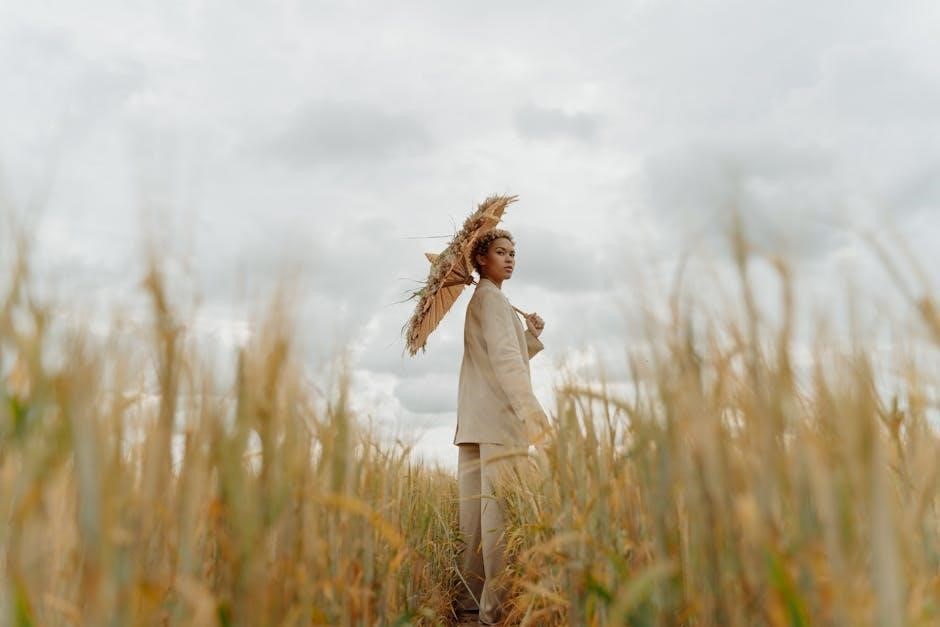“The Catcher in the Rye” by J.D. Salinger is a timeless coming-of-age story exploring Holden Caulfield’s journey through adolescence, identity, and alienation in 1950s America.
1.1 Brief Overview of the Novel
“The Catcher in the Rye” follows Holden Caulfield, a disillusioned teenager, after his expulsion from a prestigious boarding school. Navigating New York City, Holden grapples with alienation, rebellion, and the phoniness of the adult world. His interactions with peers and family, especially his younger sister Phoebe, reveal his internal conflict. The novel explores themes of adolescence, identity, and the struggle to preserve innocence, culminating in Holden’s iconic metaphor of being the “catcher in the rye,” symbolizing his desire to protect childhood purity.
1.2 Author J.D. Salinger and His Influence
J.D. Salinger, a reclusive American writer, gained fame with “The Catcher in the Rye”, a novel that became a cultural phenomenon. His unique writing style, blending humor with deep introspection, resonated with readers. Salinger’s influence extends beyond the novel, shaping young adult literature and inspiring authors like John Green. His work’s enduring relevance lies in its authentic portrayal of teenage angst and universal themes, solidifying his legacy as a literary icon.
1.3 Historical Context and Publication
“The Catcher in the Rye” was published in 1951 by Little, Brown and Company, amidst the social and cultural shifts of post-war America. The novel captured the essence of teenage rebellion and alienation, resonating with a generation navigating societal expectations. Its release marked a turning point in young adult literature, blending humor with poignant introspection. Despite initial controversies, the book became a cultural icon, reflecting the era’s complexities and enduring as a timeless exploration of adolescent struggles.

Major Themes in “The Catcher in the Rye”
The novel explores universal themes of adolescent rebellion, identity, alienation, and the struggle to preserve innocence in a world filled with phoniness and disillusionment.
2.1 The Struggle of Adolescence and Identity
Holden Caulfield’s journey mirrors the universal adolescent struggle for self-discovery. His experiences of alienation and rebellion reflect the challenges of transitioning from childhood to adulthood. The novel captures his frustration with societal expectations and his desire for authenticity. Through Holden’s voice, Salinger highlights the confusion and vulnerability that often accompany identity formation during youth. This theme resonates deeply, making Holden a relatable figure for generations navigating similar existential questions and emotional turmoil.
2.2 Alienation and Loneliness
Holden Caulfield’s profound alienation and loneliness are central to his character. His disconnection from others, whether at school or in social settings, underscores his feelings of isolation. Despite being surrounded by people, Holden often feels disconnected, reflecting the emotional isolation many adolescents experience. His criticism of others’ phoniness exacerbates his loneliness, as it prevents genuine connections. This alienation serves as both a source of comfort and pain, highlighting Holden’s struggle to reconcile his desire for independence with his need for understanding and belonging.
2.3 The Idea of Protecting Innocence
Holden Caulfield’s desire to protect innocence is a recurring theme, symbolized by his fantasy of being the “catcher in the rye,” safeguarding children from falling into corruption. This idea reflects his nostalgia for childhood purity and his fear of the phoniness of adulthood. The red hunting hat and the Museum of Natural History further emphasize his longing to preserve innocence, as these symbols represent authenticity and childhood simplicity. Holden’s protective instincts, particularly toward his younger sister Phoebe, highlight his deep-seated need to shield others from life’s harsh realities.
2.4 Rebellion Against Phoniness
Holden Caulfield’s rebellion against phoniness is a central theme, driven by his disgust for superficiality and hypocrisy. He criticizes societal norms, fake conversations, and materialism, seeking authenticity. His rejection of Stradlater and disdain for pretentious parties reflect this rebellion. However, Holden’s struggle with phoniness is also internal, as he grapples with his own inconsistencies. This rebellion highlights his desire for genuine connections and his frustration with the artificiality of the adult world, making him a relatable symbol of adolescent rebellion and existential angst.

Key Characters in the Novel
The novel focuses on Holden Caulfield, a disillusioned teenager, alongside Phoebe, his wise younger sister, and Allie, his deceased brother who symbolizes innocence.
3.1 Holden Caulfield: The Protagonist
3.2 Phoebe Caulfield: Holden’s Younger Sister
Phoebe Caulfield is Holden’s younger sister, whose wisdom and maturity surpass her age. She is one of the few people Holden genuinely respects, often seeking her advice and comfort. Phoebe’s ability to understand Holden’s complexities makes her a vital confidante, offering him a sense of stability in his turbulent world.
Phoebe’s character serves as a contrast to the phoniness Holden despises, embodying authenticity and innocence. Her presence helps Holden confront his emotional struggles, making her a pivotal figure in his journey toward self-awareness and growth.
3.3 Allie Caulfield: Holden’s Deceased Brother
Allie Caulfield, Holden’s younger brother, died three years before the story begins. His death profoundly impacts Holden, contributing to his emotional turmoil and alienation. Allie is remembered fondly by Holden as kind, intelligent, and genuine, embodying the innocence Holden strives to protect. Holden often reflects on Allie, seeking solace in memories of their bond. Allie’s absence serves as a poignant reminder of Holden’s struggle to cope with loss and his desire to preserve childhood innocence in a world he perceives as phony.
3.4 Other Significant Characters (Stradlater, Mr. Antolini, etc.)
Stradlater, Holden’s roommate, embodies the superficiality Holden despises, with his arrogance and shallow values. Mr. Antolini, a former teacher, offers Holden advice, reflecting genuine concern but also highlighting Holden’s resistance to guidance. These characters illustrate Holden’s struggles with others and his difficulty in forming meaningful connections, further emphasizing his alienation and the challenges of navigating a complex world.

Symbolism in “The Catcher in the Rye”
Exploring the symbolism in The Catcher in the Rye reveals deeper themes. Holden’s name, symbolizing “hold on” and “caul-field,” reflects his desire to preserve innocence and find his place in the world.
4.1 The Red Hunting Hat: A Symbol of Individuality
The red hunting hat is a pivotal symbol in The Catcher in the Rye, representing Holden’s individuality and nonconformity. Its vibrant color stands out, mirroring Holden’s desire to be unique in a world he often finds phony. The hat is first introduced during Holden’s visit to New York City, where he wears it to express his independence. However, he removes it in certain settings, signaling his vulnerability and struggle to balance his true self with societal expectations. The hat becomes a visual metaphor for Holden’s internal conflict, emphasizing his need to stand out while grappling with feelings of isolation and alienation.
4.2 The Museum of Natural History: A Symbol of Childhood Innocence
The Museum of Natural History symbolizes Holden’s longing for childhood innocence and stability. Its unchanged exhibits represent a world untouched by time, contrasting the chaos of adulthood. Holden finds solace in the museum, recalling memories of his younger brother Allie. The museum embodies Holden’s desire to protect children from falling into the “phony” world, reflecting his wish to preserve innocence and simplicity. It serves as a refuge from the disillusionments of growing up, highlighting Holden’s nostalgia for a purer, unchanging past.
4.3 The Catcher in the Rye: The Central Metaphor
The catcher in the rye metaphor, inspired by Robert Burns’ poem, symbolizes Holden’s desire to protect childhood innocence. He envisions himself catching children from falling off a cliff into a field of rye, representing his wish to shield them from the corrupting influences of adulthood. The red hunting hat, a symbol of individuality, further emphasizes Holden’s unique perspective. This metaphor reflects his internal struggle with growing up and his longing to preserve purity in a world he perceives as “phony.”

Literary Style and Narrative Technique
J.D. Salinger’s distinctive first-person narrative and stream of consciousness in “The Catcher in the Rye” create an intimate, authentic voice, drawing readers into Holden’s candid, often humorous reflections.
5.1 First-Person Narrative and Stream of Consciousness

J.D. Salinger employs a first-person narrative, offering an intimate perspective of Holden Caulfield’s thoughts and feelings. The stream-of-consciousness style mimics natural thought patterns, creating authenticity. This technique allows readers to connect deeply with Holden’s emotions, making his struggles and vulnerabilities relatable. The immediacy of his voice delivers raw, unfiltered insights, enhancing the novel’s emotional impact and providing a unique exploration of adolescent identity and alienation.

5.2 Use of Slang and Colloquial Language
J.D. Salinger’s use of slang and colloquial language in “The Catcher in the Rye” enhances Holden Caulfield’s authenticity. Phrases like “phoney” and “crumby” reflect Holden’s rebellious and critical nature, making his voice relatable. This informal tone bridges the gap between the narrator and reader, creating a sense of intimacy. The conversational style also underscores Holden’s emotional turmoil, making his experiences feel raw and immediate. This linguistic approach has contributed to the novel’s enduring appeal, resonating with readers across generations.
5.3 Irony and Humor in the Novel
Irony and humor in “The Catcher in the Rye” add depth to Holden Caulfield’s narrative. Salinger uses situational irony, such as Holden’s criticism of others while displaying similar flaws. Humor emerges through Holden’s sarcastic remarks and misunderstandings, like his awkward encounter with Sunny. These elements make Holden relatable and human, balancing the novel’s darker themes. The irony also highlights societal hypocrisies, while humor softens Holden’s cynicism, creating a nuanced portrayal of adolescent struggle and resilience.

Reception and Critical Analysis
“The Catcher in the Rye” sparked controversy upon release due to its language and themes, leading to bans in some schools. Critics praised Holden’s raw authenticity but criticized the novel’s bleak outlook, highlighting its impact on young adult literature.
6.1 Initial Reception and Controversies
Upon its 1951 release, “The Catcher in the Rye” received mixed reviews, with critics praising its honest portrayal of adolescence while others criticized its language and themes. Some deemed Holden Caulfield’s narrative too rebellious and cynical, leading to bans in schools. The novel’s exploration of teenage alienation and sexuality sparked debates, but its raw authenticity also earned acclaim. Despite controversies, it quickly gained popularity among young readers, resonating with their struggles and solidifying its place in literary history.
6.2 Psychological Insights into Holden Caulfield
Holden Caulfield’s narrative reveals deep psychological struggles, including identity crises, rebellion, and alienation. His expulsion from Pencey Prep symbolizes his resistance to conforming to societal expectations. Holden’s red hunting hat represents his desire for individuality, while his fixation on Phoebe underscores his need for genuine human connection. His criticisms of phoniness and hypocrisy reflect internal conflicts about growing up and losing innocence. These insights highlight Holden’s complexities as a symbol of adolescent angst and universal human struggles with belonging and authenticity.
6.3 The Novel’s Impact on Young Adult Literature
“The Catcher in the Rye” revolutionized young adult literature by introducing an authentic, relatable voice. Its exploration of adolescent struggles, rebellion, and identity resonated deeply, setting a precedent for honest storytelling. The novel’s influence is evident in works like John Green’s “Looking for Alaska,” which similarly delves into existential themes and teenage complexities. Salinger’s work remains a cornerstone, inspiring authors to tackle real issues, making it a foundational text in the genre’s evolution and enduring appeal across generations.

Cultural and Social Relevance
“The Catcher in the Rye” mirrors post-war America’s societal shifts, resonating with youth disillusionment and rebellion. Its themes of alienation and phoniness continue to captivate diverse audiences.
7.1 The Novel’s Reflection of Post-War America
“The Catcher in the Rye” offers a vivid reflection of post-war America, capturing the era’s societal shifts and youth disillusionment. Published in 1951, the novel portrays Holden Caulfield’s struggles amidst the rising materialism and conformity of the 1950s. The story critiques the superficiality of post-war culture, resonating with young readers grappling with identity and belonging. Its exploration of alienation and rebellion mirrors the broader societal changes, making it a timeless commentary on the tensions of its time.
7.2 The Influence of “The Catcher in the Rye” on Popular Culture
“The Catcher in the Rye” has profoundly shaped popular culture, inspiring countless adaptations, references, and works. Its themes of teenage angst and rebellion resonate in films, music, and literature, influencing authors like John Green. The novel’s iconic imagery, such as Holden’s red hat, has become a cultural symbol. Its exploration of identity and alienation continues to inspire new generations, cementing its legacy as a cornerstone of modern cultural discourse.
7.3 The Novel’s Enduring Appeal Across Generations
The enduring appeal of “The Catcher in the Rye” lies in its universal themes of teenage alienation, rebellion, and the struggle for identity. Each generation finds solace in Holden’s raw honesty and relatable frustrations. The novel’s timeless exploration of growing up continues to resonate with readers of all ages, making it a beloved and relevant classic. Its ability to transcend time ensures its place in the hearts of readers, offering insights into the human experience that remain as poignant today as they were decades ago.

Adaptations and Interpretations
“The Catcher in the Rye” has inspired various adaptations, including film attempts, stage plays, and modern fan art, showcasing its lasting cultural impact and interpretative versatility.
8.1 Attempts to Adapt the Novel into Film
Despite its popularity, “The Catcher in the Rye” has never been officially adapted into a film. Holden Caulfield’s internal monologue and nuanced character development pose challenges for screen adaptation. J.D. Salinger’s estate has been protective of the novel’s rights, rejecting numerous proposals over the years. The book’s unique narrative style and deep psychological insights make it difficult to translate into a visual medium without losing its essence. This has led to continued speculation but no successful film adaptation to date.
8.2 Stage Play Adaptations
Several stage play adaptations of “The Catcher in the Rye” have been attempted, though none have been officially endorsed by J.D. Salinger’s estate. These adaptations aim to capture Holden Caulfield’s internal struggles and the novel’s emotional depth. However, translating Holden’s stream-of-consciousness narrative into a stage format presents unique challenges. While some productions have been well-received, the estate’s protective stance has limited official adaptations, ensuring the novel remains primarily a literary experience rather than a theatrical one.
8.3 Modern Interpretations and Fan Art
Fans of “The Catcher in the Rye” continue to create diverse interpretations and art inspired by Holden Caulfield’s journey. From digital illustrations to fan fiction, these works reflect personal connections to the novel’s themes. Social media platforms and art communities showcase reimagined characters and scenes, blending classic motifs with contemporary styles. Such creative expressions highlight the enduring relevance of Salinger’s work, allowing new generations to engage with Holden’s story in fresh and innovative ways while preserving its timeless appeal.

